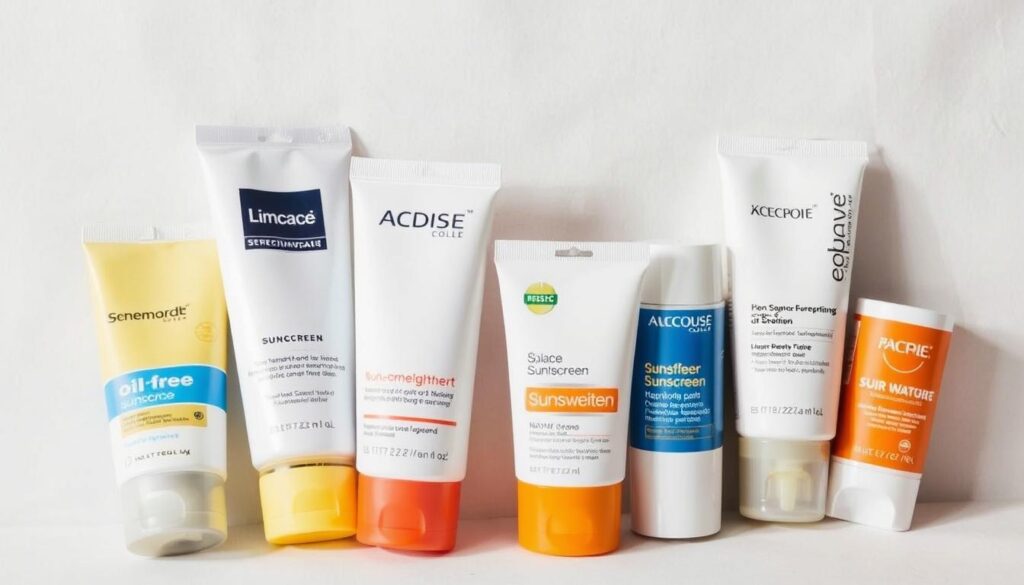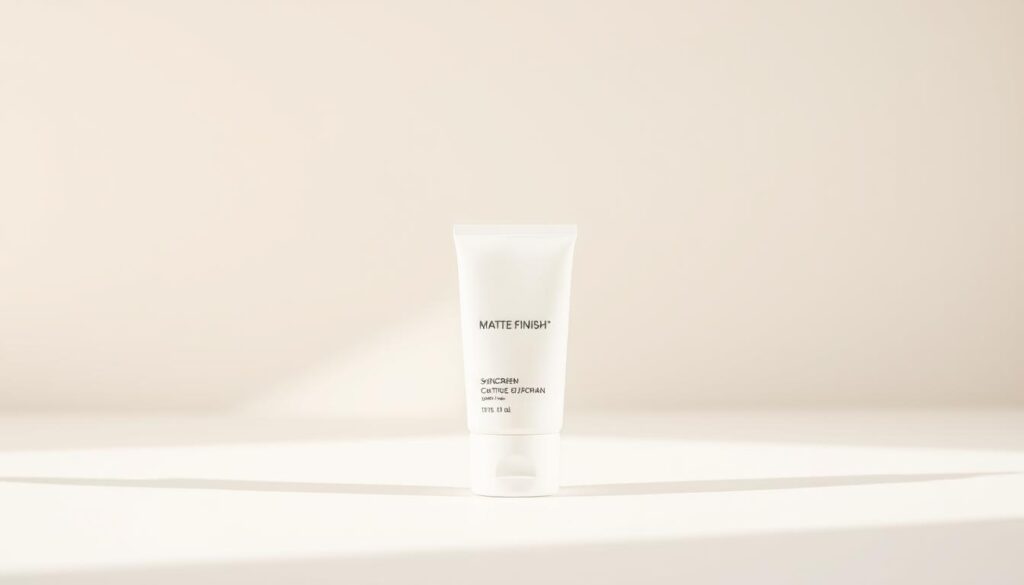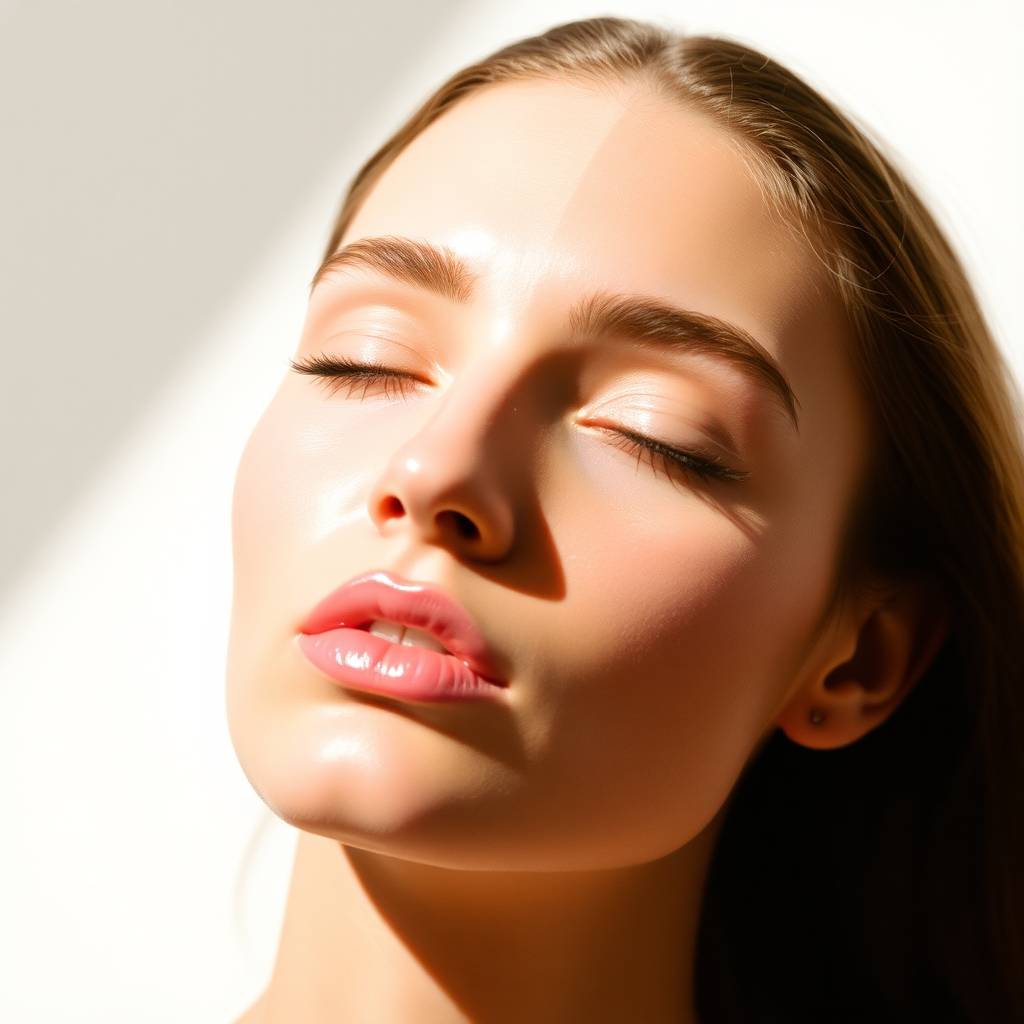Best Sunscreen for Oily, Acne-Prone Skin
Finding the right sunscreen for oily, acne-prone skin in India’s humid climate can be tough. Many sunscreens leave a greasy feel or clog pores. But, this guide helps you find the best sunscreen for oily skin.
It protects your skin without making breakouts worse. Choosing the right formula is crucial. It helps balance oil and prevents sun damage.

Key Takeaways
- Sunscreen is vital even for oily skin to prevent UV-induced damage.
- Look for non-comedogenic facial sunscreen for oily skin to avoid breakouts.
- Oil-control ingredients in formulas help manage shine without irritation.
- Humid weather makes selecting lightweight, fast-absorbing options a priority.
- SPF 30+ is enough when paired with the right texture for oily skin types.
Why Sunscreen is Essential for Oily Skin Types
Many think oily skin doesn’t need sunscreen, but that’s wrong. Sunscreen is vital for oily and acne-prone skin all year. Without it, UV rays cause inflammation, leading to more oil and clogged pores. This fuels breakouts.
Here’s how it works:
- UV rays damage skin cells, making oil glands work too hard.
- Without sunscreen, dark spots from breakouts last longer, making acne worse.
- Sun damage speeds up collagen breakdown, causing fine lines even in young skin.
Studies show the best sunscreen for oily and acne-prone skin can help control sebum. Choose lightweight, non-comedogenic formulas that won’t clog pores. In India’s hot climate, skipping sunscreen increases oiliness and sun damage risks.
Protecting your skin daily keeps your complexion balanced and prevents long-term harm. Don’t let myths stop you—your skin’s health depends on it!
Understanding Oily Skin and Its Unique Sunscreen Needs
Oily skin in India’s humid climate needs more than basic sun protection. It’s important to find a sunscreen that works with your skin, not against it.
Characteristics of Oily Skin in Humid Indian Climate
The hot, humid weather makes your skin produce more sebum. This mix of sweat and oil can make regular sunscreens feel heavy. The best sunscreen for face oily skin should be light and breathable.
Common Sunscreen Problems for Oily Skin Types
- Greasiness: Heavy formulas trap oil, making shine worse.
- White Cast: Many sunscreens leave a visible residue, especially on darker skin tones.
- Pore Clogging: Ingredients like oils or waxes can trap bacteria, leading to acne.
The Connection Between Sun Exposure and Acne
“UV rays trigger inflammation, which can turn a small pimple into a stubborn breakout.”
Sunlight doesn’t just dry skin—it damages skin cells. This stress makes glands produce more oil and clogs pores. Using the oil-free facial sunscreen helps prevent this cycle and reduces post-inflammatory hyperpigmentation too.
Key Ingredients to Look for in the Best Sunscreen for Face Oily Skin
Choosing the right sunscreen is all about knowing its ingredients. For oily skin, some ingredients are better than others. They can make a big difference in how well the sunscreen works.
Non-Comedogenic Filters: What They Are and Why They Matter
Look for non-comedogenic sunscreen for face with zinc oxide or avobenzone. These filters don’t clog pores. Physical blockers like titanium dioxide protect without irritation. Chemical filters like octinoxate absorb UV rays well.
Oil-Absorbing Ingredients That Combat Shine
- Silica or rice starch: Blot excess oil without stripping skin
- Volcanic ash: Creates a matte finish instantly
- Clay extracts: Soothe inflammation while controlling shine
Beneficial Additives for Acne-Prone Skin
Choose sunscreens with niacinamide to lessen redness or salicylic acid to clear pores. Tea tree oil helps with inflammation. Antioxidants like vitamin E fight free radicals from the sun.
Ingredients to Avoid
Avoid heavy oils like mineral oil and coconut oil. Also, stay away from fragrances that can trap dirt. Don’t use alcohol too much, as it can dry out your skin and make it oilier. Avoid occlusive ingredients like lanolin, which can block pores.
Physical vs. Chemical Sunscreens: Which Works Better for Oily Skin?
When picking the best sunscreen for face oily skin, you have two main choices: physical (mineral) and chemical. Both keep your skin safe but in different ways. Your skin’s needs will help you choose the best one.

| Criteria | Physical Sunscreens | Chemical Sunscreens |
|---|---|---|
| Key Ingredients | Zinc Oxide, Titanium Dioxide | Avobenzone, Oxybenzone |
| How They Work | Reflect UV rays like a shield | Convert UV rays to harmless heat |
| Texture | Can feel thicker but now available in lightweight forms | Typically lightweight and fast-absorbing |
| Best For | Sensitive or acne-prone skin | Those prioritizing sheer finish |
Physical sunscreens, like top-rated sunscreen for oily skin brands (e.g., Neutrogena Clear Face, L’Oreal Paris UV Perfect), use minerals. This helps avoid clogging pores. Chemical sunscreens, like Avene Mineral or Nivea Sun Fluid, give a matte finish but might cause breakouts for some. Hybrids mix both for balanced protection.
Always test small areas first. If you easily get irritated, physical sunscreens are better. For a no-shine look, chemical sunscreens might be the way to go. Always check the ingredients to avoid alcohol or fragrances that can make oiliness worse.
Top 10 Best Sunscreens for Oily and Acne-Prone Skin Available in India
Choosing the right sunscreen for oily and acne-prone skin is key. It must protect without feeling heavy. India’s humid weather means we need sunscreens that stay matte and don’t get oily. Here’s a list of top picks, from affordable to high-end, made for Indian skin.
Budget-Friendly Options Under ₹500
- Neutrogena Ultra Sheer Dry Touch SPF 50+: A favorite for its light, matte finish. It’s non-comedogenic and doesn’t clog pores.
- Lakme Sun Expert Liquid Sunscreen SPF 50+: It hydrates without feeling greasy. It has hyaluronic acid for a dewy, oil-free look.
- The Derma Co. Daily Defense SPF 50+: A budget option with a matte finish. It’s alcohol-based and great for daytime.
Mid-Range Sunscreens with Excellent Oil Control
- Re’equil Oil Control Sunscreen SPF 50: It fights shine with silica and zinc oxide. It’s perfect for acne-prone skin.
- Bioderma Photoderm Aqua SPF 50+: It’s water-resistant and good for sensitive skin. It leaves a subtle matte finish.
- La Shield Daily Sunscreen SPF 50: It hydrates without feeling sticky. It has niacinamide to reduce redness and oil.
Premium Sunscreens Worth the Investment
- Heliocare 360° Oil-Free SPF 50: It has antioxidants and a velvety matte finish.
- SkinCeuticals Physical Fusion UV Defense SPF 50: It’s a hybrid mineral formula that blends well. It’s non-greasy and reef-safe.
Indian Brands That Understand Local Skin Concerns
- Earth Rhythm Oil-Free Sunscreen SPF 50+: It’s made for Indian climates. It has aloe vera to soothe and control shine.
- Minimalist Sunscreen SPF 30: It’s a minimalist blend with essential ingredients. It creates a natural matte finish.
- Dr. Sheth’s Oil Control Sunscreen SPF 50+: It’s non-comedogenic and tested for Indian skin types.
Matte Finish Sunscreens That Keep Shine at Bay All Day
Don’t let oil and shine ruin your day. Matte finish sunscreen for oily skin offers sun protection without oiliness. Look for oil-free facial sunscreen with silica or microspheres to control oil. Brands like Innisfree and Etude House are great for humid climates.

COSRX Aloe Soothing Sun Cream combines aloe vera with zinc oxide for soothing and oil control. La Roche-Posay Anthelios Oil Correction uses powders to reduce shine. Always check for non-comedogenic labels and test on your skin.
“The Etude House Sunprise never feels heavy. It’s my go-to before applying foundation!” – Mumbai-based user review
Use blotting papers midday for touch-ups. Remember, sunscreen needs to be reapplied every 2–3 hours, especially when sweating. For a matte look, layer with a translucent powder without oils. Choose products tested in Indian conditions for best results.
How to Apply Sunscreen on Oily Skin for Maximum Protection
Learning how to apply sunscreen is crucial to avoid feeling greasy while staying protected. Start by cleaning and moisturizing your skin with a light formula. Then, use the “two-finger rule” for the right amount: a pea for small faces, two peas for larger ones. Remember, too much can clog pores.
Application Techniques That Prevent Greasiness
- Use the dot and blend method: Dab sunscreen on cheeks, forehead, and chin, then gently tap it in with clean fingers.
- Try the patting technique: Tap sunscreen into skin with a damp sponge for even absorption. This works well with gel-based sunscreens.
- Avoid rubbing vigorously—this can irritate skin and increase oiliness. Blend gently using upward motions.
Reapplication Tips for Throughout the Day
Reapplying sunscreen every 2–3 hours keeps sun protection for oily face intact. Use these tricks:
- Carry a sunscreen mist like Nyra Naturals’ gel spray for touch-ups without heaviness.
- Try a powder sunscreen (e.g., Lakmé Sun Expert 50SPF) to refresh coverage midday.
- Blot excess oil first, then apply a thin layer of mineral sunscreen to avoid residue buildup.
Pair these tips with a non-comedogenic formula to keep pores clear. Consistency matters—protecting your skin doesn’t have to mean greasiness!
Combining Sunscreen with Your Skincare Routine for Oily Skin
Creating a skincare routine with lightweight sunscreen for oily skin needs balance. Start by layering products correctly to avoid clogged pores and too much oil. Here’s a simple morning routine:
- Cleanse with a gentle gel cleanser to remove overnight oil buildup.
- Use a mattifying serum (like salicylic acid) to treat acne without adding grease.
- Optional: Apply a thin layer of non-greasy moisturizer if your skin feels tight.
- Wait 5 minutes for products to absorb before applying your non-comedogenic sunscreen for face.
Pair your non-comedogenic sunscreen for face with oil-free primers instead of heavy makeup bases. For example:
| Product Pairing | Why It Works |
|---|---|
| Nykaa The Sunscreen SPF50+ | Blends smoothly under oil-control powders |
| Vaseline Clinical Advanced UV Defense | Hydrates without residue when paired with clay masks |
“Always apply sunscreen last in the morning to lock in other products without interfering with their efficacy,” advises dermatologist Dr. Meera Agarwal.
Evening routines should focus on double-cleansing with micellar water followed by a salicylic acid toner. This removes sunscreen residue without stripping skin. Choose lightweight formulas like Lakme’s Sun Expert range for seamless layering. Remember: less is more—over-moisturizing before sunscreen traps oil and worsens breakouts.
Sunscreen Myths Debunked: What Oily Skin Types Need to Know
Protecting your skin doesn’t mean it has to feel heavy or cause breakouts. Let’s debunk common myths so you can find the best sunscreen for oily and acne-prone skin easily.
Myth: Sunscreen Always Causes Breakouts
Many think all sunscreens clog pores. But today’s sunscreens are made differently. Look for “non-comedogenic” labels and ingredients like zinc oxide.
“Oil-free sunscreens with salicylic acid can even help control acne,” says Dr. Mehta, a dermatologist in Mumbai.
Choose products tested for acne-prone skin to avoid breakouts.
Myth: Higher SPF Means Greasier Formula
SPF measures UVB protection, not how thick it feels. A top-rated sunscreen for oily skin with SPF 50+ can feel as light as lower SPF ones. Brands like Nykaa’s Liquid Sunscreen SPF 50 show that you don’t need a thick texture.
Myth: Dark Skin Doesn’t Need Sunscreen
Hyperpigmentation and dark spots? UV rays are a big cause. Even darker skin needs protection. Dermatologists say to use sunscreen daily to prevent darkening, especially in India’s sunny weather.
Myth: Sunscreen on Cloudy Days Is Unnecessary
UV rays go through clouds, causing damage even indoors. They also make acne worse. So, apply sunscreen every day, rain or shine, to stay safe.
Real User Reviews: What Indians with Oily Skin Say About These Sunscreens
People all over India share their experiences with oily, acne-prone skin. They talk about the best sunscreens:
“The Lakme Sun Expert Sunscreen sits perfectly under my makeup in Mumbai’s humidity. No white cast, and it lasts through monsoon rains!” – Priya, 28, Mumbai
| Product | City | Review Highlights |
|---|---|---|
| Neutrogena Ultra Sheer | Delhi | Lightweight sunscreen for oily skin that fights pollution. Left my skin matte but needed reapplying post-swimming. |
| Vaseline Clean Skincare Sunscreen | Chennai | Oil-free facial sunscreen that blends instantly. Didn’t clog pores, even after 8-hour office shifts. |
| Lotus Herbals Neem Sunscreen | Kolkata | Combined neem extracts with SPF 50. Reduced shine but felt slightly sticky on humid days. |
In hybrid climates like Ahmedabad, people love the lightweight sunscreen for oily skin from Forest Research. One user said, “It doesn’t clash with my turmeric face packs!” In Delhi, commuters say L’Oreal Paris UV Perfect line fights pollution well. They all agree: stay away from thick creams and choose gels or lotions.
Many prefer gel-based formulas like Himalaya Sunscreen Gel for layering with traditional ingredients. But, some had breakouts with alcohol-heavy sprays. The key takeaway? Always test small amounts first and look for non-comedogenic labels.
Conclusion: Finding Your Perfect Sunscreen Match for Oily Skin
Finding the right sunscreen for oily skin is all about finding the right balance. Look for sunscreens with broad-spectrum SPF 30-50+, and are labeled as non-comedogenic. These should also have ingredients that absorb oil.
Choose sunscreens made for oily skin types, especially those designed for Indian climates. Always test a small amount first to avoid any breakouts, especially if you have acne-prone skin.
Remember, what works for one person might not work for another. If a sunscreen feels too heavy, try a lightweight gel or mist. For a matte finish, look for sunscreens with silica or rice starch.
If you’re on a budget, there are options under ₹500. But, if you’re willing to spend more, premium sunscreens with antioxidants might be worth it. Always reapply sunscreen every two hours, even indoors, to keep your skin protected.
Don’t give up if you’ve tried sunscreens before and didn’t like them. Every brand has something different to offer. Some focus on controlling oil, while others aim to reduce white cast.
Keep track of what works for you and mix sunscreen with lightweight moisturizers to avoid clogged pores. With time, you’ll find a routine that keeps your skin balanced and protected. Your perfect sunscreen is out there—just keep looking and don’t give up!
FAQ
What is the best sunscreen for face oily skin?
For oily skin, choose a sunscreen that’s lightweight and oil-free. It should also be non-comedogenic to avoid clogged pores. Look for “matte finish” products or those with silica or rice starch.
Are there any top-rated sunscreens for oily skin?
Yes, Neutrogena Ultra Sheer Dry Touch and La Roche-Posay Anthelios Oil Correction are great. They control oil well and feel light on your skin.
What should I look for in an oil-free facial sunscreen?
An oil-free sunscreen should have non-comedogenic filters. It should also protect against all types of sun rays. A matte finish is best to control shine.
Can matte finish sunscreen really keep shine at bay?
Yes! Matte sunscreens absorb oil, keeping your skin fresh and shine-free longer.
Which non-comedogenic sunscreens are recommended for the face?
Bioderma Photoderm AKN Mat and Re’equil Ultra Matte Dry-Touch Sunscreen are good. They prevent breakouts and are great for oily and acne-prone skin.
What is the best sunscreen for oily and acne-prone skin?
The best sunscreen is lightweight, oil-free, and has niacinamide or salicylic acid. These help with acne and protect from the sun.
How do I apply sunscreen on oily skin for maximum effectiveness?
Use the two-finger rule for the right amount. Apply gently to feel lighter. Reapply every two hours. Use powder sunscreens for easy touch-ups without adding oiliness.
Are there any specific ingredients to avoid in sunscreen if I have oily skin?
Yes, avoid heavy oils, fragrances, and high alcohol content. They can make oiliness worse and cause breakouts.
Can I wear sunscreen under makeup for oily skin?
Yes, you can wear sunscreen under makeup. Choose a lightweight, matte-finish sunscreen for oily skin. It ensures a smooth application and reduces shine.
Should I use sunscreen every day, even if it’s cloudy or I’m indoors?
Absolutely! UV rays can go through clouds and windows. Daily sunscreen use prevents skin issues like hyperpigmentation and premature aging.

Leave a Reply